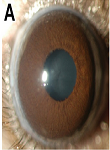|
|
|
New pigmentation genes linked to iris transillumination defects in BXD glaucoma murine st
|
|
|
|
|
|
|
|
|
|

|
|
|
Shankar Swaminathan, Hong Lu, Robert W. Williams, Lu Lu, and Monica M. Jablonski.
|
|
|
|
University of Tennessee, Memphis, TN: Nantong University, Nantong, China
|
University of Tennessee Health Science Center, Memphis, TN: Nantong University, Nantong, China
|
|
sswamin4@uthsc.edu
|
|
|
|
|
|
|
|
|
|

|
The iris and iridial melanin are important influencers of vision. The mouse iris, due to its dense pigmentation, is unique and presents a powerful opportunity for studying pigment cell biology. Pigmentation abnormalities are clinically significant; as they can lead to albinism, iris transillumination defects (TIDs), and potentially pigment dispersion glaucoma. Despite its well-†documented biological significance, there is a clear knowledge gap surrounding the basic molecular and cellular processes influencing pigmentation of the iris. It is a complex genetic trait controlled by an intricate network of genes whose coordination and regulation are poorly understood.
|
|
|
|
|
|
|
|

|
|